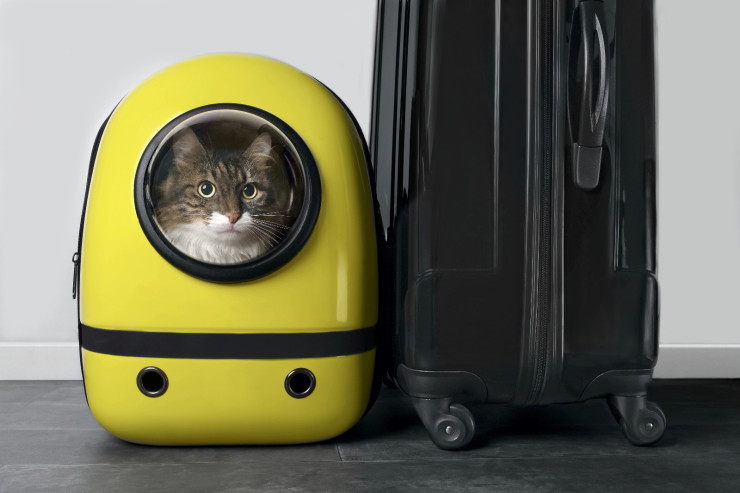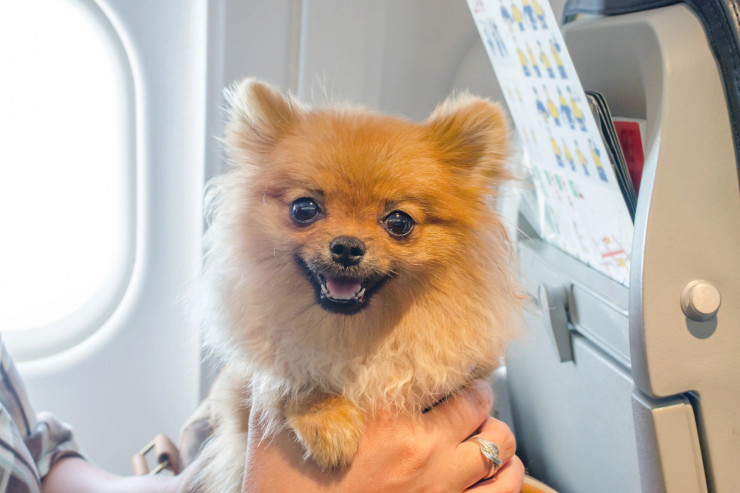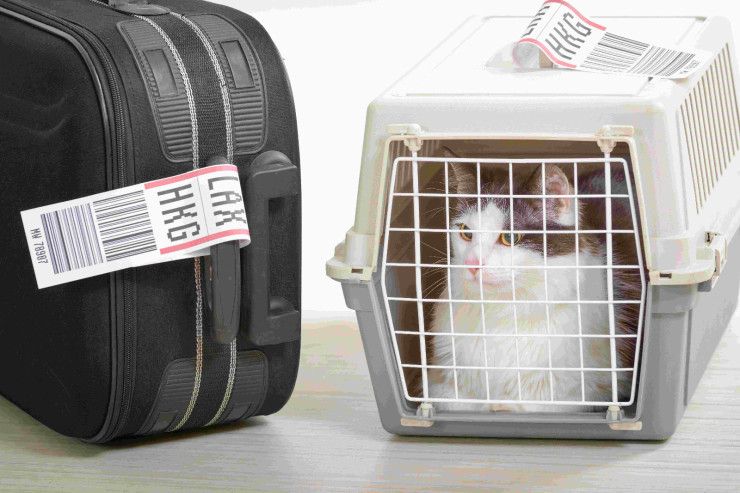Tengrinews.kz - Traveling with a pet on board an airplane is always stressful for both owners and their pets. To minimize risks and ensure safety, it is important to know the rules and requirements of airlines. We have collected the necessary information on how to properly transport pets on airplanes to avoid tragedy.
Transporting pets on board an airplane requires careful compliance with the rules established by airlines and airports. The recent incident with SCAT Airlines at Astana Airport has become a reason to discuss the importance of these rules and the responsibility borne by both air carriers and airport services.
Kazakhstani woman's cat was lost at Astana airport
A reader, Ekaterina Barlas, wrote to our editorial number on WhatsApp and talked about what happened to her on October 4. She was flying from Istanbul to Astana with a cat, but the staff of the airline carrier did not let the animal on board in her hand luggage.
As a result, Ekaterina did not see her pet anymore. As she was later explained, at the airport of arrival, the loader dropped the container with her cat, the lid opened, and the terrified animal fled in an unknown direction. The woman complained that the airport staff was not active enough in finding the pet.
"Before boarding the flight, we paid $40 (about 20 000 tenge) for the cat. Upon arrival in Astana, we waited for her for a long time in the luggage compartment, but the container still did not arrive. Then an airport employee called SCAT and asked one of the employees to come to us and clarify the situation. He informed us that the cat had run away," she said.
Ekaterina and her husband wrote a statement to the police. She told us that they did not want to give her access to the security cameras of the air harbor.
"Already on the spot, we learned that the flight attendant of the airline saw how the loader, pulling out a carrier with a cat from a special compartment of the aircraft, dropped the carrier, as a result, the animal escaped," Ekaterina continued.
The passenger also clarified that there is another version: the loader put the carrier on the tape with the door already open from the corner and the cat ran away by itself.
"Now the loader is trying to evade responsibility. SCAT has sent information that the search has officially been terminated. But how can you stop searching when the cat is not found?" she said.
 Photo from Ekaterina Barlas
Photo from Ekaterina Barlas
We contacted the press service of Astana Airport for a comment, where we were told that the incident really happened and an internal investigation is currently underway.
"During the unloading of the luggage of flight DV492, an incident occurred, as a result of which the cat broke free and ran away. Currently, all the CCTV footage has been thoroughly reviewed, but the cat has not been found. A commission has been set up in connection with the incident, and an internal investigation is underway. The search continues," shared the representatives of the air harbor.
The airport also added that the owner of the cat on October 22 viewed the camera footage for October 4, that is, two and a half weeks after the disappearance.
"The process of disembarking passengers and unloading luggage was reviewed, but the cat was not visible on the recordings. There is also no data confirming the fact that the carrier fell. The baggage unloading procedure was carried out under the supervision of the airline's flight attendants, who can confirm that the employee did not drop the cage. Representatives of the airport are in touch with the owner of the cat," the press service said.
 Photo: depositphotos.com
Photo: depositphotos.com
SCAT Airlines, in turn, expressed regret about the incident, noting that the cat was transported in accordance with the rules, and the incident occurred while transporting luggage to the terminal.
"The transportation of the animal was carried out according to the company's rules as checked baggage in an isolated heated trunk of the aircraft. Upon arrival, at the time of baggage transportation from the plane to the terminal building by airport services, the integrity of the animal container was violated. Unfortunately, this led to the animal running out.
The airline and airport staff on-site took all possible actions to capture the animal, but unfortunately, they were not successful. On behalf of the airline, we express our sincere sympathy to the owners of the lost animal and do everything possible to help find it," the airline said.
We decided to find out how things are with the rules of carriage of air carriers. Is there really no way to take animals on board with you?
Rules for animal transportation by airlines
As it turned out, the requirements for transporting animals can vary significantly depending on the airline. However, the basic principles of animal safety and care remain unchanged.
General requirements
Transportation of pets is allowed only with prior approval from the airline and if all necessary documents are available (veterinary passport, a certificate from a veterinarian, and others, depending on the route). Each airline has its own restrictions on the permissible weight, size, and number of animals on board, so check the requirements in advance at the booking stage.
 Photo: depositphotos.com
Photo: depositphotos.com
Documents
Mandatory for all airlines:
- A veterinary passport confirming the availability of all necessary vaccinations;
- A health certificate from a veterinarian received no earlier than 3 days before departure;
- In some cases, additional documents are required for international transportation (for example, export and import permits, and titration of rabies antibodies).
However, the full list of documents depends on whether in (or through) which country and which airline the tourist is going to take the pet. The lists and rules can be viewed on the official websites of air carriers.
Vaccination and chipping of animals
The pet must be vaccinated against rabies and other diseases in accordance with the requirements of the country of departure and destination. For international flights, it is necessary to have a chip on the animal so that it can be easily identified.
Containers and carriers
- Animals are transported only in specialized containers or carriers, which should ensure the safety and comfort of the pet.
- The container should be spacious enough for the animal to get up, lie down and turn around.
- Containers should be ventilated, with a solid structure and a moisture-proof bottom.
- For birds, it is necessary to close the cage with an opaque material to exclude the ingress of light.
- The dimensions and weight of the container depend on the specific requirements of the airline and the class of transportation.
Note that each airline has its own rules. It is necessary to clarify the details directly with the carrier in advance.
 Photo: depositphotos.com
Photo: depositphotos.com
Prices for transportation of animals
The cost of transporting pets varies depending on the airline.
- SCAT: depending on the weight of the pet, the cost can range from 5 000 to 25 000 tenge on domestic flights and from 40 to 250 dollars on international flights;
- FlyArystan: the price varies from 12 000 tenge to 30 000 tenge on domestic flights, from $43 to $ 86 on international flights;
- Qazaq Air: transportation of animals up to 5 kilograms costs 12 000 tenge on domestic and 40 euros on international flights;
- Air Astana: the cost depends on the weight of the animal and the type of flight: detailed fares are available on the airline's website.
Transportation in the cabin and luggage compartment
- SCAT: Carriage in the cabin is not allowed, however, guide dogs accompanying passengers with visual and/or hearing impairments are transported on board the aircraft without a container, subject to certain conditions. All other animals are transported only in the baggage compartments as checked baggage. Transportation in the luggage compartment: animals (cats, dogs) up to 50 kilograms can be transported in the luggage compartment. The weight of the animal and container is not included in the free baggage allowance and is paid at a special rate.
- FlyArystan: small cats, turtles, and dogs (up to 8 kilograms) can be transported in the cabin. Larger animals up to 50 kilograms are transported in the luggage compartments. The animal must be in a special carrier.
- Qazaq Air: Only animals weighing up to 5 kilograms are allowed in the cabin. Passengers also have the opportunity to transport pets up to 8 kilograms in the next seat on direct flights. The airline does not accept for transportation: wild animals, large domestic animals, fur-bearing animals, rodents, and reptiles.
- Air Astana: pets up to 8 kilograms are allowed in the cabin. Larger pets can be transported in cargo compartments. At the same time, the maximum permissible weight is 50 kilograms, including the weight of the container or cage.
Thus, of all Kazakhstani airlines, only SCAT prohibits transporting pets in the cabin. Therefore, if you are going on a trip with an animal, it is better to find out such moments in advance, before buying tickets.
Tickets and preparation
- It is necessary to book the pet transportation service in advance, 24 hours before departure.
- When booking, specify the type, weight, and size of the pet to make sure that the airline will be able to accommodate it on board.
- The pet must be fed and watered 2 hours before departure, as well as inspected for travel readiness.
- Upon registration, present all documents and pay the cost of transportation.
Behavior on board when transporting an animal in the cabin
- Location of the animal: The carrier with the animal should be under the seat in front of you throughout the flight. Placing the carrier on your lap or in the aisle is prohibited.
- It is forbidden to open the container or release the animal from the carrier during the flight. The animal must remain in a closed container for the entire time it is on the plane.
- Make sure that the animal feels comfortable in carrying. The container must provide good ventilation so that the animal can breathe.
- The animal must be in a calm state. If the pet is showing anxiety, it is recommended to consult with a veterinarian in advance about possible sedatives.
- You can take a small bowl of water with you to offer the animal to drink after takeoff and before landing. However, do not leave water in the container throughout the flight, so as not to spill liquid.
- If the animal begins to show signs of stress or anxiety, stay calm and try to calm it down with your voice without opening the container. Passengers are not allowed to take the animal out of the carrier even if the pet starts to worry or make sounds. Contact a crew member for recommendations.
- After landing, stay in your seat until the plane stops completely and the crew members allow the exit. Do not open the container until it is completely out of the plane, even if the animal seems agitated.
When traveling with an animal on international flights, it is important to keep in mind that each country has its own rules and requirements for the import of pets. Transporting animals abroad requires careful preparation to avoid unexpected difficulties at customs and ensure safe border crossing.
For example, the requirements for documents may vary significantly depending on the country. Some States require an international veterinary passport, a veterinary health certificate, chipping, and even a permit for the import of animals. Make sure that your pet meets all the requirements of the destination country (for example, a certain age, allowed breeds, and more). Some countries have restrictions on the import of certain breeds of dogs and cats.
It should be noted that airlines are most often not responsible in case of refusal to import an animal from a particular country and all related costs are paid by the passenger.
In 2024, Kazakhstan expanded its international air connections by launching new routes to cities like Irkutsk and Mumbai. In the coming years, routes to Tokyo and New York are planned.
New type of visa for foreigners was introduced in Kazakhstan


